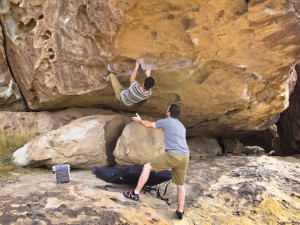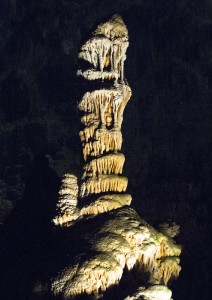
Big Bend is the 31st National Park we’ve visited—only 27 more to go. The park’s Chisos Basin can arguably be compared to Yosemite and Zion—perhaps a distant cousin but stunningly worthy nonetheless, not to mention the hundreds of species of birds that migrate through. Big Bend borders Mexico in SW Texas, and the route we took was magnificent, each stop featuring something truly amazing that forms the basis for these posts. Our journey from Arizona was a bit more anxiety producing than what we’re accustomed to, however. For that I take the blame. But when’s the last time you’ve driven through 2 time zones in a couple hundred miles?
We departed Arizona’s Chiricahua National Monument, screamed into and out of New Mexico and then, to make matters worse, discovered I’d mistakingly made reservations for Hueco Tanks State Park for the following night. Oops. It was Sunday, and after several futile phone messages to a robot, I got a call from the park superintendent who, thankfully, corrected my mistake and made it clear they close the gate to the park precisely at 5 p.m. (those were her exact words). This came into play big time because we’d unknowingly crossed into Mountain time and lost an hour, requiring us to drive faster than comfortable (never approaching the 80 mph speed Texas speed limit, however) and arrived with 30-minutes to spare. Whew!

Hueco Tanks is named for igneous rock material that was pushed up (in the form of fluid magma) into an older limestone formation, nearly surfaced (but didn’t) and then hardened. The limestone eroded away and weather shaped the exposed igneous material into its present form. Hollows (huecos) and fracture patterns in the massive granite-like formations capture precious rainfall to establish a relatively moist environment, providing home to endemic bacteria and freshwater shrimp that somehow survive given the limited rainfall in this desert area near El Paso. Due to this periodic availability of water, the area has been home to humans for 10,000 years and is considered sacred to native Americans.

Because of these fractures in the rock faces, the area has become a world-class destination for rock climbers because the surfaces provide perfect assists for bouldering (climbing freestyle without ropes). Furthermore, hidden throughout the area are roughly 2,000 petroglyphs (scratchings) and pictographs (paintings) applied by ancients. The art that’s relatively easy to access has been, sadly, vandalized beyond recognition; initially by settlers in the mid-1800’s who simply joined the party and added their names as historical records. These are actually interesting and are honored by park historians who speculate that some of their contributions intentionally de-faced the Indian art in revenge for lives lost during westward expansion. More recently, graffiti has been sprayed on some beautiful specimens that the Texas park service has painstakingly attempted to remove. Much art, thankfully, remains and we had fun looking for it.
Protective measures are in place the moment you arrive. Our arrival was met by more than usual paperwork, a 20-minute video to watch, passes issued, and an 8 a.m. check-in each day for the requisite pass. Oh, yeah, the place closes at 6 p.m. and that also caught us by surprise. That said, it’s abundantly clear why these precautions are necessary to inhibit further damage by insensitive visitors. The mound we were permitted to explore resulted in an otherworldly adventure as we climbed, watched climbers, got lost, found our way again, and slid on our backs into openings barely a couple feet high, their surfaces smoothed by thousand years of other visitors (not all wearing REI hiking garments). And not a sign to be seen; access to Kiva Cave would have been impossible without a laminated map we exchanged for our driver’s license. Park administrators don’t make it easy, but our Hueco Tanks visit was memorable.

Our next destination was, thankfully, a short drive and we arrived at Guadalupe Mountain National Park in the early afternoon. The Guadalupe Mountains are among the best examples of a marine fossil reef. In essence, the sea bottom that comprised this region 260-270 million years ago was composed of sponges, algae, and other lime-secreting marine organisms. As the sea evaporated, it was buried by a thick blanket of sediments and mineral salts that entombed the sea bottom (consisting of those sponges and smooth, round stones not unlike those found on the Oregon coast). They were glued together with an epoxy-like material that bonded everything together into what I can only describe as rocks of rocks. Over millions of years, these layers have reappeared by mountain-building uplift and continue to amaze hikers and scientists from all over the world. That and, of course, the towering 8,000’ peaks that surround the valley including the highest mountain in Texas.

The following morning, we drove to Carlsbad Caverns National Park in nearby New Mexico and spent several hours wandering the largest cave in north America before returning to Texas for a stunning sunset. Before continuing our journey to Davis Mountain State park, located in the shadow of McDonald observatory and host of NPR’s Star Date fame, we hiked McKittrick Canyon donated to the park service by its former owner, Wallace Pratt, the owner of Humble Oil Co. (later to became Exxon). A geologist, Pratt was exploring the area and a friend asked him if he’d like to see the most beautiful place in Texas. What he found he bought, all 5,000 acres of it, due to the remarkable oaks, maples, pines and abundant wildlife nestled in profoundly beautiful canyons of what is now part of Guadalupe Mountain NP. His family gifted the entire area to the park service around 1960, and his “lodge” remains for all to enjoy. A mile farther is the “Grotto,” a shallow cave right on the trail that features stalagmites and stalactites of its own. Our refresher course at the caverns the day before made this particularly intriguing since we didn’t have to descend 750’ to access it. What’s more interesting, carbolic acid is still dripping from the upper surface and continues to build the grotto’s features.
Davis Mt. State Park is an easy drive from Guadalupe National Park. The highlight of our route on Hwy. 118 was the late afternoon sun with long shadows around every bend of the beautiful oak hillsides and rounding a turn to see the several domed telescopes of McDonald Observatory. The following morning Sooney took off on a solo hike but quickly connected with a couple other birders. Along the way, she encountered a small heard of wild goats that I would have loved to see.
That evening, we all headed up to the McDonald Observatory to participate in their “Star Party” that, under different conditions, would have had us exploring the universe using the public-friendly telescopes designed especially for these events. Alas, the evening was overcast but we were not disappointed since they are the quintessential pros; 20-minute sessions each in the auditorium for a narrated graphical presentation, to a classroom lecture on exoplanets, and outdoors to the two telescopes originally intended for us to use but fully entertaining with specialists answering every question from the simple to the profound. All in layperson’s lingo. The weather failed us the following morning as well as we were unable to view the total lunar eclipse. But that got us up early for our final plunge to Big Bend National park.
Big Bend is huge; an entire mountain range is contained within its 1,200 square miles. We headed first to Cottonwood campground both for the birds and the availability of a campsite. We’ve been paralleling spring breaks throughout this entire journey, and the following day was Easter. Our neighbor’s children found 28 plastic eggs and Sooney spotted her 4th & 5th NEW “life” birds, a Crissal Thrasher and a Yellow-fronted Woodpecker. We hiked the Santa Elena trail to the Rio Grande river canyon that separates Texas from Mexico. It was fun harmonizing a tune and hearing our echo bounce off 1500’ canyon walls. Folks hiking behind us said it was real purdy, too.

For something entirely different, a roughly 40 mile drive into the interior of the park took us to the Chisos basin that is nearly surrounded by magnificent peaks. The Chisos mountains are a virtual sky island in the middle of the Chihuahuan desert, and temperatures are often 15-20° cooler than on the desert floor. The mountains also receive upwards to 20” of rainfall annually, and in the upper elevations it’s not unusual to see aspen, maples, fir, and oaks. Needless to say, this unique ecosystem provides perfect habitat for the 54 resident birds and the 109 birds that breed here. In all, 450 birds have been identified within the park, mostly migratory. We ascended 1,600′ hiking the grueling 10-mile Pinnacle trail looking for the elusive Colima Warbler, but the little rascal got away. Returning from the all-day hike to an unbelievable sunset was partial compensation, however. The campground is located in the center of the basin and surrounded by stunning panoramas that simply fail to pale. It’ll be hard to edit the accompanying slide show to the requisite 20 or so images but that’ll be fun to do when not eating barbecue in Austin. Ciao.
Sightings along this leg of the journey:
Hueco Tanks State Park
Say’s Phoebe, White-winged Dove, Black-throated Sparrow, * Cassin’s Sparrow, Chipping Sparrow, White-crowned Sparrow, Lincoln’s Sparrow, Hermit Thrush, Ruby-crowned Kinglet, Ladder-backed Woodpecker, Canyon Towhee, Green-tailed Towhee, Spotted Towhee, Dark-eyed Junco, American Robin, Western Scrub Jay, Northern Mockingbird, Pyrrhuloxia, Canyon Wren, Turkey Vulture, Red-tailed Hawk, White-throated Swift, American Kestrel
Guadalupe National Park
Bushtit, Rufous-crowned Sparrow, Chipping Sparrow, Canyon Wren, Canyon Towhee, Spotted Towhee, Say’s Phoebe, Western Scrub Jay, Black-chinned Hummingbird, Cedar Waxwing, Turkey Vulture, Common Poorwill, black-tailed rattlesnake
Davis Mountain State Park
Northern Mockingbird, Barn Swallow, Say’s Phoebe, Northern Cardinal, Ladder-backed Woodpecker, Chipping Sparrow, Black-throated Sparrow, Rufous-crowned Sparrow, * Black-crested Titmouse, Bewick’s Wren, Canyon Wren, Canyon Towhee, House Finch, Pine Siskin, Lesser Goldfinch, Red-tailed Hawk, Raven, White-winged Dove
Big Bend National Park – Cottonwood campground
* Yellow-fronted Woodpecker, Vermillion Flycatcher, Inca Dove, Blue-gray Gnatcatcher, Yellow-rumped Warbler, Bell’s Vireo, Northern Cardinal, * Crissal Thrasher, Northern Mockingbird, Western Kingbird, Gray Hawk, Greater Roadrunner, Great Horned Owl on nest, Lesser Goldfinch, Summer Tanager
Big Bend National Park – Chisos Basin Campground
Say’s Phoebe, Mockingbird, Cactus Wren, Curved-bill Thrasher, Canyon Towhee
Pinnacles Hike
Black-crested Titmouse, Dark-eyed Junco, Rufous-crowned Sparrow, Canyon Towhee, Mexican Jay, Bushtit, Acorn Woodpecker, Ladder-backed Woodpecker, Ruby-crowned Kinglet, Chipping Sparrow, Hutton’s Vireo, House Wren, Blue-gray Gnatcatcher, Black-tailed Gnatcatcher, Blue-throated Hummingbird, Roadrunner
Rio Grande Visitor Center/Store
Common Black Hawk, Bell’s Vireo
Dugout Wells Hike
Northern Cardinal, White-crowned Sparrow, Yellow-rumped Warbler, Wilson’s Warbler, Bell’s Vireo, Ash-throated Flycatcher, Mockingbird, Verdin, Mourning Dove, House Finch, Roadrunner,
Dogs Canyon Hike
White-winged Dove, Chihuahuan Raven, Say’s Phoebe, Pyrrhuloxia, Black-throated Sparrow, large flock of Lark Bunting, large flock of Brewer’s Sparrow, Loggerhead Shrike
* Life birds in this posting: 4
